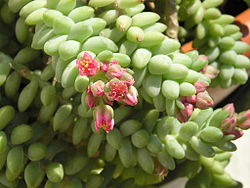Sedum morganianum
| Sedum morganianum subsp. var. | Burro's tail, Donkey's tail | |||||||||||||||||||||||||||||||||||||||||||||||||||||||
|---|---|---|---|---|---|---|---|---|---|---|---|---|---|---|---|---|---|---|---|---|---|---|---|---|---|---|---|---|---|---|---|---|---|---|---|---|---|---|---|---|---|---|---|---|---|---|---|---|---|---|---|---|---|---|---|---|

|
|
| ||||||||||||||||||||||||||||||||||||||||||||||||||||||
| ||||||||||||||||||||||||||||||||||||||||||||||||||||||||
Sedum morganianum (commonly called burro's tail or donkey tail) is a succulent plant which is native to southern Mexico and Honduras. It produces long trailing stems up to 60 cm long with fleshy blue-green leaves and produces terminal, pink to red flowers.
Cultivation
The species is a popular houseplant and is primarily grown for the foliage; flowers are produced infrequently. Plants are best grown in full sunlight for strong growth and to enhance leaf colouration. The species is susceptible to over-watering, especially during winter dormancy.
Propagation
Plants are usually propagated by stem or leaf cuttings. The leaves are quite delicate and will readily break off the stem when manipulated. The leaves will stay alive for many days and roots will emerge after a few days.
Pests and diseases
Varieties
This particular plant has shorter stems and shorter, rounder leaves. The leaves are less prone to breaking off the stem.[1] It is often labeled as a distinct species under the name Sedum burrito and it is not clear at the moment whether it actually was bred as a distinct cultivar or if it evolved from S. morganianum as a subspecies in the wild.[2][3]
Gallery
-
Here it is in full bloom, which may be once or twice a year, or never- depends on the climate and light conditions.
-
Photographed at Volunteer Park Conservatory, Seattle, Washington.
-
Sedum morganianum in Dalat, Vietnam.
-
Sedum morganianum (habit). Location: Maui, Kula Ace Hardware and Nursery
-
Sedum morganianum 'Burrito' variation.
References
External links
- w:Sedum morganianum. Some of the material on this page may be from Wikipedia, under the Creative Commons license.
- Sedum morganianum QR Code (Size 50, 100, 200, 500)





